 |
Kaay Centre, Skidegate, Haida Gwaii |
|
|
|
|
|
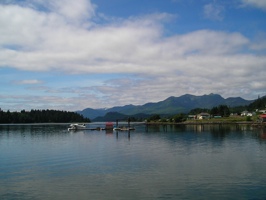 |
We are blessed with extraordinarily fine weather during our visit. Further south, the Sunshine Coast and Nanaimo region are suffering record temperatures and drought -- over 30C -- but here it is a mild 22C, gentle weather. Not too many travellers have returned from the Charlottes with sunny, cheerful pictures; most travelogues involve a lot of raingear. We are seeing Beaver Bay at its scenic best. |
|
|
|
|
|
 |
One of those peaks is called Sleeping Beauty and is a favourite local climbing spot. We wish we had access to a 4WD vehicle to go into the back country (on the ubiquitous logging roads) and up the mountain; but we're restricted to the use of our feet and whatever free time Kim can spend driving us around to see the sights. |
|
|
|
|
|
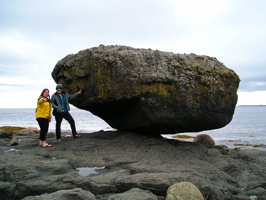 |
Kim kindly takes us on a little jaunt up the coast to see various local attractions. Balance Rock has been a local landmark for centuries; the Haida traditionally believed that if the rock toppled over, the islands would sink back into the sea. The Charlottes have deep cosmogonic significance for the Haida: they are where the First People were discovered by Raven, hiding under a shell (iirc). |
|
|
|
|
|
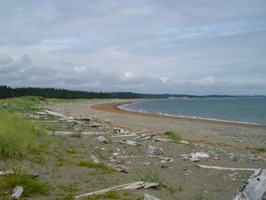 |
Long Beach on the east coast of Graham Island, north of Skidegate; a gorgeous lonely expanse of coarse sand and pebbles. Low dunes separate it from the coastal road; in winter, waves break over the dunes and the road is sometimes flooded. Winds of 80km and higher are not uncommon. But it's summer and though swimming or sunbathing seem unlikely, the beach is welcoming. I'm delighted by these large open spaces after the confinement of Full Moon's cramped cabin and wheelhouse! |
|
|
|
|
|
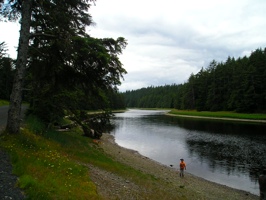 |
The Tlell River, where locals fish and hang out, is the centre of a sparse semirural residential area. There are a few farms, some artists and artisans, and some official park land. It's an idyllic place in the summertime. The river immediately inspires thoughts of canoes and kayaks. |
|
|
|
|
|
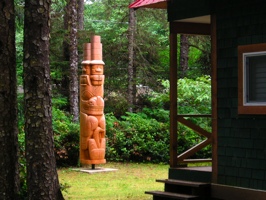 |
In the back yard of a Tlell house -- probably the house of a Haida carver -- we see a small pole crowned with Watchmen figures. |
|
|
|
|
|
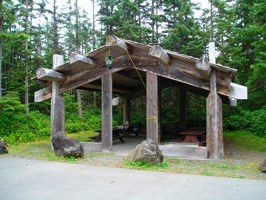 |
A visitor shelter at a provincial park is built in Haida style, from great balks of cedar. A camper has suspended food in a bag high off the ground, to keep it away from black bears. There are no grizzlies in Haida Gwaii, but grizzlies appear on some totem poles due to intermarriage with Haida from Alaska. |
|
|
|
|
|
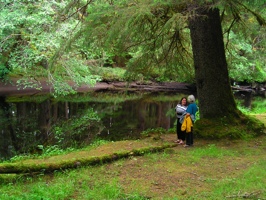 |
Jon took a picture of Kim and me chatting by a tributary of the Tlell, a quiet stream lined with trees of respectable size. The landscape is green and remarkably quiet, the water almost tea-coloured but very clear. |
|
|
|
|
|
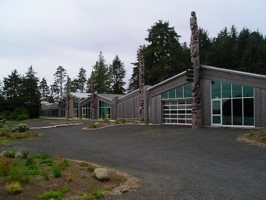 |
Returning to Beaver Bay, we pay a visit to the wonderful Kaay Centre, a Haida cultural centre and museum just outside Skidegate. It is built on an old village site, the architecture inspired by the layout of a traditional Haida village. Large cedar houses face the water across a strip of open land; tall totem poles dominate the house fronts. These were some of the first poles raised in Skidegate since the great die-off (in the late 1800's, when smallpox and TB decimated the Haida people). |
|
|
|
|
|
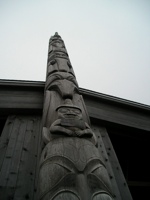 |
The Haida carving style is immediately recognisable for its elegance, crisp detail and sophistication of line and form. |
|
|
|
|
|
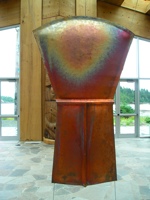 |
We are requested not to take pictures of the museum exhibits and respectfully comply (though I'm rather annoyed to see other visitors ignoring the signage and snapping away throughout the display rooms). This sculpture based on a traditional "copper" is in the lobby, where we are allowed to use cameras. Coppers -- big shield-shaped forms of hammered copper -- were a form of tangible, durable wealth among high-ranking Haida. Chiefs displayed their coppers at home, or gave them to greatly favoured friends or allies. In form they are all similar to this one, but the degree of decoration varies considerably. Some say the shape is inspired by the sea turtle shell. |
|
|
|
|
|
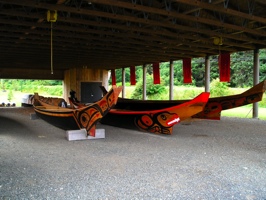 |
In the museum we saw more amazing and beautiful artifacts than I can recollect or describe: of particular interest to me were the weavings (straw and fibre) which were of a startling precision and sophistication; as one exhibit legend remarked, it was difficult for early Anglo travellers to believe that Haida cloth and basketry had been made by hand and not by machine, because it was so perfect and regular. Our jaws dropped more than once at the high level of skill, technique and design demonstrated in jewelry, clothing, utensils, funerary boxes, etc. But perhaps my favourite exhibit (where cameras were fortunately permitted) was the Canoe Shed. |
|
|
|
|
|
 |
Here we saw perhaps the most famous signature artifact of the Haida nation: the dugout canoes in which Haida travelled amazing distances for purposes of commerce and war. |
|
|
|
|
|
 |
These canoes were formed by carving out (with axes and adzes) the trunk of a single cedar tree, then using hot stones and water to soften and bend the wood into a suitable shape. |
|
|
|
|
|
 |
After the hull was complete, it would be decorated with bold graphic designs, and each canoe would have an individual name. Haida canoes had such a reputation in pre-colonial times that they were a much-coveted trade good. Haida would paddle a few of their exquisite canoes over to the mainland and return in inferior mainland canoes loaded to the gunnels with valuable cargo given in exchange for the boats. |
|
|
|
|
|
 |
Haida graphics are striking, hovering on the edge between representational and abstract art. |
|
|
|
|
|
 |
The canoe graphics particularly pleased me because of the way they meet the challenge of filling such an irregular space, all curved boundaries. |
|
|
|
|
|
 |
This one was my favourite. |
|
|
|
|
|
 |
We spent quite a long time among the canoes, admiring and photographing in a kind of stunned silence, blown away by the dignity and beauty of the craft. |
|
|
|
|
|
 |
In the same shed we were privileged to see a totem pole in progress, being carved out of a large cedar trunk. |
|
|
|
|
|
 |
The Kaay Centre not only preserves and displays historical artifacts, but is a living cultural centre where Haida practise and teach carving, basketry, jewellery making, weaving, traditional foodways, and language. The art of Haida basket weaving almost died completely when the population was decimated; it was preserved by the diligent efforts of a tiny handful of women (as in many cultures, weaving in Haida Gwaii was traditionally a woman's art). This pole in progress reminds us that the art we see here is not a dead tradition but a living one. Haida artists are still developing and furthering their art. |
|
|
|
|
|
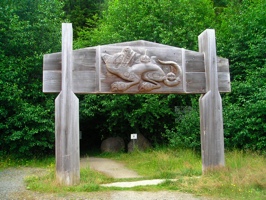 |
A little further down the highway is Spirit Lake, a small park with a hiking trail. After the somewhat overwhelming indoor experience of the Kaay Centre (which to my surprise included a first-rate cafe/restaurant featuring nouvelle cuisine and local ingredients), we were glad to get outdoors for a while. The entrance to the park is decorated with a formal archway featuring Wasco, a legendary sea-wolf-dog creature. Wasco has particular local significance because he's said to show up (like the Loch Ness Monster) in Spirit Lake just up the trail from here; legend has it that he has a secret tunnel enabling him to travel from the sea to the lake and back! Wasco is also the name of a local dog, a notoriously huge and overly friendly golden retriever; alas, we never saw the sea-creature or his canine namesake on our visit. |
|
|
|
|
|
 |
The trails around Spirit Lakes were very attractive and enticing. Though not a large park, it felt remote and interesting, not entirely tame. |
|
|
|
|
|
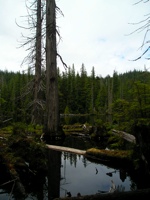 |
Jon took this moody, atmospheric shot of the lake. It looked pretty much like any coastal BC lake... |
|
|
|
|
|
 |
... but the equisedum along the trail were the largest I have ever seen -- waist high and taller. We wandered back down to the nearest coffee shop only to find it closed, which scotched our plans for calling a taxi. So we walked back to QCC along the coast road, a somewhat weary plod after a long day but enlivened by berry picking along the verges. Our first day of tourism on Graham island had been very full indeed. |
|
|
|
|
|